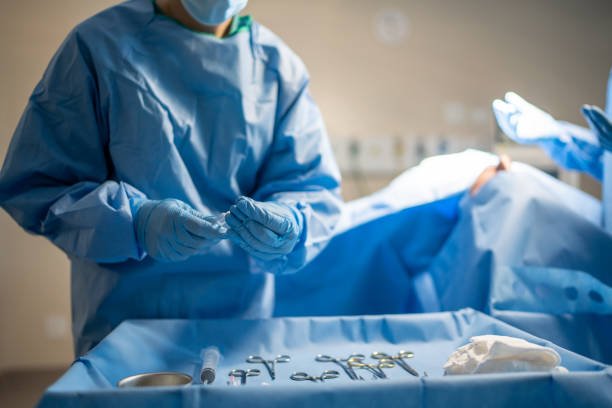Home / Major and Minor Surgeries

Appendectomy is the surgical removal of the appendix, a small, tube-shaped organ attached to the large intestine. It is typically performed as an emergency procedure to treat appendicitis, a condition where the appendix becomes inflamed and infected. The surgery can be done using an open method or laparoscopic technique, with the latter offering quicker recovery and smaller incisions. If left untreated, a ruptured appendix can lead to serious infections in the abdominal cavity. Appendectomy is a common and effective procedure, usually resulting in full recovery with minimal complications.
A breast biopsy is a diagnostic procedure where a small sample of breast tissue is removed and examined under a microscope to determine if a lump or abnormality is benign or cancerous. It may be done using needle biopsy, stereotactic biopsy, or surgical excision, depending on the location and size of the lesion. This procedure is often recommended when imaging tests (like mammograms or ultrasounds) detect suspicious changes. Breast biopsies play a critical role in early detection and treatment planning for breast cancer or other breast conditions, and are typically done under local anesthesia with minimal discomfort.
Carotid endarterectomy is a surgical procedure to remove plaque buildup from the carotid arteries—the main arteries in the neck that supply blood to the brain. This surgery is performed to reduce the risk of stroke in patients with significant artery narrowing (stenosis), often due to atherosclerosis. The surgeon makes an incision in the neck, opens the artery, and removes the plaque to restore proper blood flow. Carotid endarterectomy is considered a preventive measure for patients with symptoms like transient ischemic attacks (TIAs) or those with severe artery blockage detected through imaging.
Cataract surgery is a common procedure to remove a clouded lens from the eye and replace it with an artificial intraocular lens (IOL). Cataracts cause blurry vision, glare, and difficulty seeing at night, especially in older adults. The surgery is typically performed on an outpatient basis under local anesthesia. The most common technique is phacoemulsification, where ultrasound waves break up the cloudy lens before removal. Vision typically improves dramatically after the procedure. Cataract surgery is safe and effective, restoring clear vision and enhancing the patient’s quality of life.
Hemorrhoidectomy is the surgical removal of hemorrhoids, which are swollen veins in the anus or lower rectum. This procedure is usually recommended for severe or recurring hemorrhoids that do not respond to non-surgical treatments. The surgery may involve excision, stapling, or laser treatment, depending on the type and severity of the hemorrhoids. It is typically performed under spinal or general anesthesia. While hemorrhoidectomy provides long-term relief, it may involve a recovery period with some post-operative discomfort. It effectively resolves symptoms like bleeding, pain, and itching, restoring normal bowel habits.
A free skin graft is a surgical technique in which a section of skin is completely removed from one area of the body (donor site) and transplanted to another area (recipient site) where skin has been lost due to injury, burns, surgery, or ulcers. The graft can be split-thickness (epidermis and part of dermis) or full-thickness (epidermis and full dermis), depending on the need. The graft relies on the recipient site’s blood supply to survive and integrate. Free skin grafts are crucial for wound healing, cosmetic restoration, and prevention of infections in large or deep skin loss cases.
Kidney stone surgery refers to various procedures used to remove stones from the kidney or urinary tract when they are too large to pass naturally. Common methods include ureteroscopy, percutaneous nephrolithotomy (PCNL), and shock wave lithotripsy (SWL). Surgery is recommended when stones cause severe pain, infection, or block urine flow. The choice of procedure depends on the size, location, and composition of the stone. Kidney stone surgery is generally safe and highly effective, and may involve a short recovery period. Preventive guidance is also offered to avoid recurrence through diet and lifestyle changes.
Gallbladder surgery, or cholecystectomy, is the removal of the gallbladder—an organ that stores bile used for digestion. It is most often performed to treat gallstones that cause pain, inflammation (cholecystitis), or infection. The surgery can be done using a laparoscopic (minimally invasive) approach or traditional open surgery. Laparoscopic cholecystectomy involves small incisions and typically allows faster recovery. Removing the gallbladder does not affect digestion significantly in most people. The procedure relieves symptoms such as abdominal pain, bloating, and nausea, and prevents future gallstone-related complications.

Dr. Sankhwar Hospital in Kondli has been a trusted name in healthcare for over 35 years, offering comprehensive multi-speciality medical services. Led by Mr. Subodh Sankhwar and Dr. Meghali Sankhwar
+919560002583
help@drsankhwarhospital.com
D-134, DR SANKHWAR HOSPITAL ROAD, Kondli Extension, Kondli, Delhi, 110096
Copyright © 2025 Dr. Shankhwar Hospital| All Right Reserved. Designed by ❤️ PromotionAdda